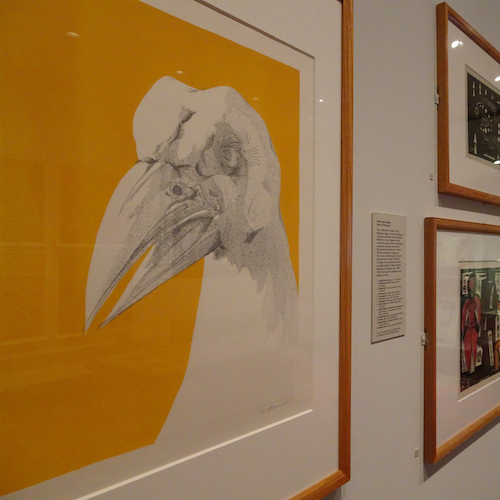 Iranian Voices at the British Museum
Iranian Voices at the British Museum
The British Museum is less than five minutes by foot from the Pickwick, so I could only put off visiting for so long before the guilt got to me.

There’s so much to see, and no shortage of signs suggesting you might make the museum a multi-day endeavor. Right at the entrance is that singularly stunning skylight, and the excellent Moving Stories exhibit that you can read about in the other posts on this blog. On Wednesday, I went in search of something different.
Tucked away downstairs in the John Addis Islamic Gallery is the Iranian Voices exhibit, a collection of the museum’s recent acquisitions of contemporary Iranian art. It’s a compact display – the artwork occupies all of three display cases and two walls in a small open space. Most of the floor area is commanded by an exquisite Persian carpet that I almost couldn’t bring myself to walk on.
The pieces on display range from lithographs and collages to aquatints and digital and analog photographs. Parviz Tanavoli’s Heech was the standout work for me, visually – it’s a recycled paper sculpture of the Persian word for nothing carved from a book, which is exactly as edgy as you’d think, and twice as elegant.

It’s a beautiful and striking arrangement. When you consider the spectrum of forms on display, though, the subheading in the exhibit’s title starts to seem a little peculiar. Recent acquisitions of works on paper, it reads. But, you might wonder, isn’t that kind of an arbitrary organizing principle when paper is hardly the most prominent feature in most of the works on display? How important is it to specifically recognize the medium of these pieces when such an understanding reveals little about their form or content? Essentially, what does it matter that this art involves paper?
Good question.
In foregrounding the medium of paper as a unifying feature, Iranian Voices prompts a deeper exploration into the nature of labels. We may expect two works of art on paper to bear at least some visual resemblance to each other, but the variety on display in Iranian Voices swiftly dismisses such a notion as limiting and untrue. When the term works on paper matters less to us, it comes to encompass more.

The exhibit does the same thing with a label like “Iranian.” Sure, the featured artists have ethnicity in common, but why should that determine that they share political inclinations, religious beliefs, social values, economic status, language, gender, or geography? The works of the artists on display engage with an incredible diversity of concerns. Mitra Tabrizian’s Surveillance (1990) chronicles the historical involvement in Iranian politics of the West and the clergy. Strikingly, women are front and center in the print, highlighting their political importance and already undermining casual narratives of female repression in the Middle East. Parastou Forouhar’s Red is my name, green is my name (2008) at first glance depicts simple Persian-styled wallpaper, but upon closer inspection yields disturbing images of victims’ contorted bodies – it is a powerful commentary on oversimplified representations of Iran. Tarlan Rafiee’s handmade prints supply a colorful depiction of oft-overlooked Middle Eastern pop culture. Ahmad Aali’s Portrait of Bahman Mohasses (1968) is a character study of the contemporary Iranian artist. Then there’s Parviz Tanavoli’s aforementioned Heech, which its caption doesn’t explain and honestly neither can I. The point is that each artist brings something different to the canvas, and in doing so expands our understanding, not of a single, simply contained THE IRANIAN EXPERIENCE, but of the countless possibilities open to Iranian experiencers.

We’ve just started reading Sam Selvon’s The Lonely Londoners (1956), which also discusses labels and their limitations. The book follows the lives of West Indian immigrants to London following the Second World War. In a reactionary pushback against the influx of West Indians, the predominantly white English population projects uncharitable stereotypes onto the new arrivals:
“Like one time when newspapers say that the West Indians think that the streets of London paved with gold a Jamaican fellar went to the income tax office to find out something and first thing the clerk tell him is, ‘You people think the streets of London are paved with gold?’” (2).
Selvon’s book, however, is a celebration of the heterogeneity of the West Indian in London, providing the reader windows into the colorful lives of one character at a time. It demonstrates that Moses’s veteran level-headedness, Daniel’s aspirational affluence, Captain’s reckless charisma, and Tanty’s no-nonsense sass are all realizations of West Indian-ness, and Selvon’s London is richer for it.
Today, as with every day before, there are those who would utilize reductive labels and stereotypes to perpetuate ignorance and intolerance. But the virtue of labels – Iranian, Islamic, contemporary, feminist, in protest, on paper – rests in the understanding that they are always plural. Unpacking them is an important endeavor and one that’s always worth your time, even when there isn’t a museum next door.
~ Nathaniel Chew, ’19
Iranian Voices is a free exhibit that runs till 21 May 2017.
